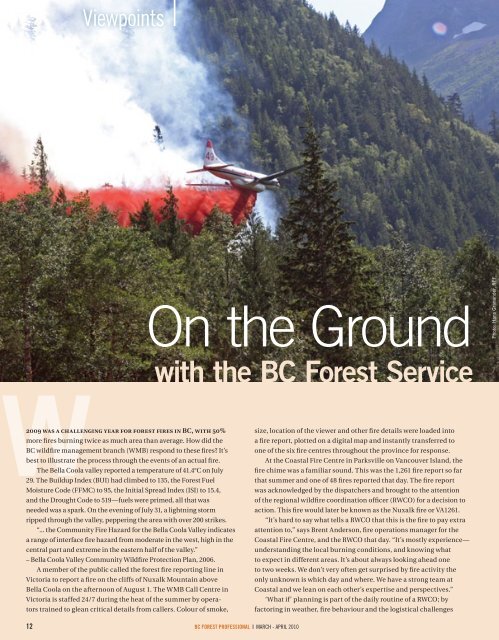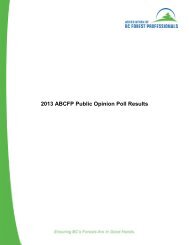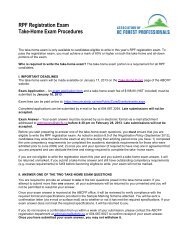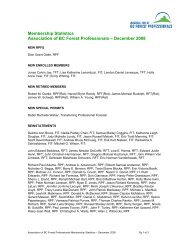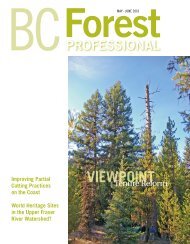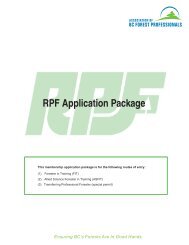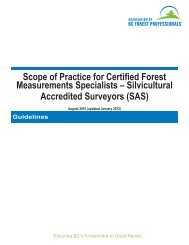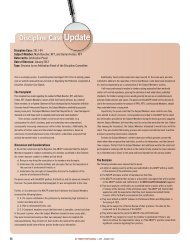VIEWPOINT - Association of BC Forest Professionals
VIEWPOINT - Association of BC Forest Professionals
VIEWPOINT - Association of BC Forest Professionals
Create successful ePaper yourself
Turn your PDF publications into a flip-book with our unique Google optimized e-Paper software.
Viewpoints<br />
W2009 was a challenging year for forest fires in <strong>BC</strong>, with 50%<br />
more fires burning twice as much area than average. How did the<br />
<strong>BC</strong> wildfire management branch (WMB) respond to these fires? It’s<br />
best to illustrate the process through the events <strong>of</strong> an actual fire.<br />
The Bella Coola valley reported a temperature <strong>of</strong> 41.4°C on July<br />
29. The Buildup Index (BUI) had climbed to 135, the <strong>Forest</strong> Fuel<br />
Moisture Code (FFMC) to 95, the Initial Spread Index (ISI) to 15.4,<br />
and the Drought Code to 519—fuels were primed, all that was<br />
needed was a spark. On the evening <strong>of</strong> July 31, a lightning storm<br />
ripped through the valley, peppering the area with over 200 strikes.<br />
“... the Community Fire Hazard for the Bella Coola Valley indicates<br />
a range <strong>of</strong> interface fire hazard from moderate in the west, high in the<br />
central part and extreme in the eastern half <strong>of</strong> the valley.”<br />
– Bella Coola Valley Community Wildfire Protection Plan, 2006.<br />
A member <strong>of</strong> the public called the forest fire reporting line in<br />
Victoria to report a fire on the cliffs <strong>of</strong> Nuxalk Mountain above<br />
Bella Coola on the afternoon <strong>of</strong> August 1. The WMB Call Centre in<br />
Victoria is staffed 24/7 during the heat <strong>of</strong> the summer by operators<br />
trained to glean critical details from callers. Colour <strong>of</strong> smoke,<br />
On the Ground<br />
with the <strong>BC</strong> <strong>Forest</strong> Service<br />
12 <strong>BC</strong> FOREST PROFESSIONAL | MARCH - ApRil 2010<br />
size, location <strong>of</strong> the viewer and other fire details were loaded into<br />
a fire report, plotted on a digital map and instantly transferred to<br />
one <strong>of</strong> the six fire centres throughout the province for response.<br />
At the Coastal Fire Centre in Parksville on Vancouver Island, the<br />
fire chime was a familiar sound. This was the 1,261 fire report so far<br />
that summer and one <strong>of</strong> 48 fires reported that day. The fire report<br />
was acknowledged by the dispatchers and brought to the attention<br />
<strong>of</strong> the regional wildfire coordination <strong>of</strong>ficer (RWCO) for a decision to<br />
action. This fire would later be known as the Nuxalk fire or VA1261.<br />
“It’s hard to say what tells a RWCO that this is the fire to pay extra<br />
attention to,” says Brent Anderson, fire operations manager for the<br />
Coastal Fire Centre, and the RWCO that day. “It’s mostly experience—<br />
understanding the local burning conditions, and knowing what<br />
to expect in different areas. It’s about always looking ahead one<br />
to two weeks. We don’t very <strong>of</strong>ten get surprised by fire activity─the<br />
only unknown is which day and where. We have a strong team at<br />
Coastal and we lean on each other’s expertise and perspectives.”<br />
‘What if’ planning is part <strong>of</strong> the daily routine <strong>of</strong> a RWCO; by<br />
factoring in weather, fire behaviour and the logistical challenges<br />
Photo: Hans Granander, RPF


